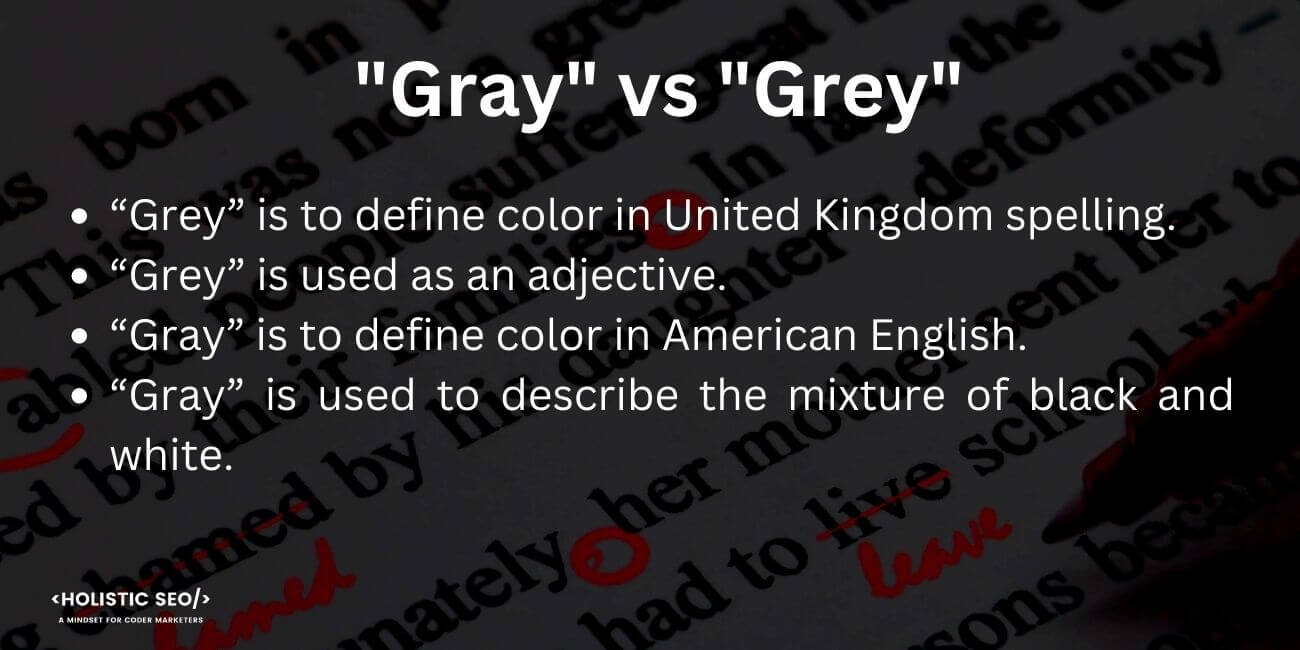“Gray or grey?” A common dilemma faced by many when it comes to choosing the right shade. The distinction may seem trivial, but the impact it can have on your style and aesthetics is significant. While both spellings refer to the same color, nuances in usage can vary by region. Understanding the subtle differences can elevate your design choices and communication skills. Let’s delve into the world of gray or grey and navigate the intricacies of this versatile hue.
Exploring the World of Gray or Grey
What is Gray or Grey?
When you look around, you may notice a color that seems like a mix of black and white. That color is called “gray” in American English and “grey” in British English. It’s a fascinating color that can be found in nature, art, and even in our daily lives.
The Science Behind Gray or Grey
Believe it or not, gray isn’t just a mixture of black and white. It actually has its own wavelength and intensity. In the world of colors, gray is considered a neutral color because it doesn’t have any dominant hue. This makes it a versatile color that can complement many other shades.
Did you know that gray is often associated with feelings of stability and sophistication? Many people choose gray for their homes or offices because it can create a calming and balanced atmosphere.
Shades of Gray or Grey
Just like there are many shades of blue or green, gray also comes in various tones and hues. From light gray to dark charcoal, there’s a whole spectrum of grays to choose from. Each shade can evoke different emotions and create unique vibes in a space.
Light gray, for example, can make a room feel airy and spacious, while dark gray can add a sense of drama and coziness. Choosing the right shade of gray is all about understanding the mood you want to create and the overall design of the space.
Popular Gray or Grey Combinations
Gray is known for its ability to pair well with almost any other color. Whether you like bright and bold hues or soft pastels, gray can act as a perfect backdrop to make those colors pop. Some popular color combinations with gray include:
– Gray and yellow for a cheerful and modern look.
– Gray and blue for a calming and serene ambiance.
– Gray and pink for a soft and feminine touch.
– Gray and white for a classic and timeless feel.
Experimenting with different color combinations can help you discover the magic of gray and how it can transform a space.
Gray or Grey in Nature
Have you ever noticed how many animals and plants have gray in their color palette? From elephants and dolphins to clouds and rocks, gray can be found all around us in the natural world. Let’s take a closer look at how gray plays a role in nature:
– **Animal Adaptations**: Many animals use gray as a form of camouflage to blend into their surroundings and avoid predators. For example, gray wolves have fur that helps them hide in the shadows of the forest.
– **Weather Phenomena**: Gray skies are a common sight, especially on cloudy days. These gray clouds are actually water droplets or ice crystals that scatter sunlight, creating a diffused gray light.
– **Geological Wonders**: Rocks and minerals often display shades of gray due to the presence of minerals like quartz and granite. These gray rocks can form stunning landscapes and natural formations.
By observing how gray appears in nature, we can appreciate the beauty and functionality of this versatile color.
Gray or Grey in Art and Fashion
Artists and fashion designers have long been inspired by the possibilities of gray. Whether it’s in a painting or a stylish outfit, gray can convey a range of emotions and aesthetics. Let’s delve into how gray is used in art and fashion:
– **Monochrome Masterpieces**: Some artists create stunning black and white paintings with various shades of gray. These monochromatic artworks can evoke a sense of timelessness and elegance.
– **Fashion Forward**: Gray has become a staple color in the fashion industry. From gray suits to gray dresses, this versatile color can be dressed up or down for any occasion. Mixing different textures and shades of gray can create a chic and sophisticated look.
By exploring how artists and designers use gray, we can see how this color continues to be a timeless and versatile choice in the creative world.
Color Psychology of Gray or Grey
Colors can have a powerful impact on our emotions and behaviors. Gray is no exception—it has its own psychological effects that influence how we perceive the world around us. Let’s take a closer look at the psychology of gray:
– **Neutral and Balanced**: Gray is often seen as a balanced and neutral color. It can help create a sense of calmness and stability in a space.
– **Sophistication and Elegance**: Many people associate gray with sophistication and elegance. Wearing gray or incorporating it into your home decor can elevate the overall look and feel.
– **Emotional Resonance**: Some people may find gray to be a melancholic color, while others see it as a comforting and soothing shade. The emotional impact of gray can vary depending on personal experiences and cultural influences.
Understanding the psychology of gray can help you make intentional choices when using this color in your environment.
Gray or Grey in Pop Culture
Gray has made its mark in pop culture through various mediums such as movies, music, and literature. Let’s explore how gray plays a role in our favorite forms of entertainment:
– **Movie Magic**: In film, gray is often used to create mood and atmosphere. From film noir classics to modern dramas, gray cinematography can set the tone for a story.
– **Musical Lyrics**: Many songwriters use gray as a metaphor for ambiguity or uncertainty. The lyrics may reference gray skies or gray areas to convey a sense of emotional complexity.
– **Literary Symbolism**: In literature, gray can symbolize themes of ambiguity, conformity, or even wisdom. Authors may use gray imagery to evoke a particular mood or to explore deeper philosophical concepts.
By examining how gray is portrayed in pop culture, we can see how this color continues to be a rich source of inspiration for artists and storytellers.
In conclusion, gray or grey is more than just a color—it’s a versatile and multifaceted hue that plays a significant role in our lives. Whether you’re decorating your bedroom, admiring nature’s beauty, or enjoying a movie, chances are you’ll encounter shades of gray along the way. By understanding the science, psychology, and cultural significance of gray, we can develop a deeper appreciation for this timeless color. So next time you see a gray cloud in the sky or a gray sweater in a store, take a moment to consider the beauty and complexity of gray or grey.
Want your Gray Hair to Shine? Try This! Adore Clear Rinse on Gray Natural Hair | High Porosity
Frequently Asked Questions
What is the correct spelling: gray or grey?
The correct spelling is subjective to geographical location. In American English, ‘gray’ is preferred, while in British English, ‘grey’ is the standard spelling. Both spellings are considered correct globally.
Can ‘gray’ and ‘grey’ be used interchangeably?
Yes, ‘gray’ and ‘grey’ can be used interchangeably without any difference in meaning. The choice between the two spellings typically depends on the writer’s preference or the regional variation of English being used.
Is there a difference in pronunciation between ‘gray’ and ‘grey’?
No, there is no difference in pronunciation between ‘gray’ and ‘grey.’ Both spellings are pronounced the same way, regardless of which version of English is being spoken.
Final Thoughts
In conclusion, the debate between ‘gray’ and ‘grey’ may seem trivial, but it reflects the nuances of language and cultural variations. Both spellings are correct, with ‘gray’ being the predominant form in American English, while ‘grey’ is more common in British English. Regardless of your preference for ‘gray or grey,’ what truly matters is effective communication. Ultimately, language is a tool for connection and understanding, so as long as your message is clear, the spelling is just a detail.

